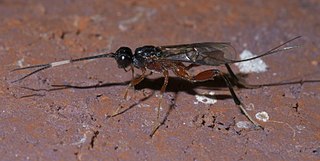
Trigonalidae is a family of parasitic wasps in the suborder Apocrita. They are the only living members of the superfamily Trigonaloidea. Trigonalidae are divided into 2 subfamilies; Orthogonalinae and Trigonalinae. These wasps are extremely rare, but surprisingly diverse, with over 90 species in 16 genera, and are known from all parts of the world. It is possibly the sister group to all Aculeata.

Microgastrinae is a subfamily of braconid wasps, encompassing almost 3,000 described species, with an estimated 30,000–50,000 total species. This makes it one of the richest subfamilies with the most species of parasitoid wasps.

Agathidinae is a subfamily of braconid parasitoid wasps. Some species have been used in biological control programs.

The Doryctinae or doryctine wasps are a large subfamily of parasitoid wasps within the family Braconidae.

The Thynnidae are a family of large, solitary wasps whose larvae are almost universally parasitoids of various beetle larvae, especially those in the superfamily Scarabaeoidea. Until recently, the constituents of this family were classified in the family Tiphiidae, but multiple studies have independently confirmed that thynnids are a separate lineage.

The Rogadinae are a large subfamily of braconid parasitoid wasps. Several Rogadinae species parasitize pest caterpillars and are important for naturally occurring biological control.

Wroughtonia is a genus of braconid wasps in the family Braconidae. There are over 40 described species in Wroughtonia.

Helconinae is a subfamily of braconid wasps in the family Braconidae.

Amiseginae is a subfamily of cuckoo wasps in the family Chrysididae. There are more than 30 genera and 150 described species in Amiseginae. The group occurs worldwide, and they are parasitoids of stick insect eggs (Phasmatodea). Females of some genera are flightless and resemble ants.
Snellenius is a genus of braconid wasps in the family Braconidae. There are more than 40 described species in Snellenius, found in Asia, Oceania, and the Neotropics.
Pseudogonalos is a genus of parasitic wasps belonging to the family Trigonalidae. Members of these genus vary from 5.5mm to 13.9mm in length.

Embolemus is a genus of wasps belonging to the family Embolemidae. There is debate regarding the status of the genus named Ampulicomorpha by Ashmead in 1893, generally considered now to be a junior synonym of Embolemus (e.g.,), as a few authorities dispute this (e.g.,).

Taeniogonalos gestroi is a species of wasp in the family Trigonalidae. It is a hyperparasitoid that parasitise Ichneumonidae and Tachinidae larva inside the caterpillars of Lepidoptera.
Rogadini is a tribe of parasitoid wasp in the family Braconidae. It is represented in the entire world. It is the largest tribe within the subfamily Rogadinae with 40 extant genera. It is also considered to be the most basal tribe in the subfamily.











